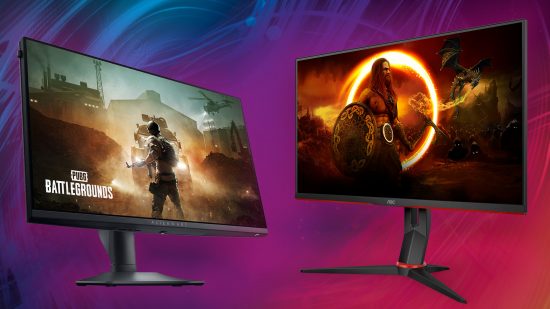Are you looking for the best gaming monitor to suit your needs? If so, this is the place to be. Our gaming monitor guide includes a wide selection of displays to suit all needs, from small, budget gaming monitors, through ultra-fast 240Hz and 360Hz esports gaming monitors to enormous 4K panels.
Here are the best gaming monitors in 2023:
- LG Ultragear 27GP850-B – the best 27-inch gaming monitor
- AOC 27G2SPU – the best budget 27-inch gaming monitor
- Dough Spectrum One – the best 27-inch 4k gaming monitor
- Alienware AW2523HF – the best esports monitor
- AOC 24G2U – the best budget 24-inch gaming monitor
- Dell G3223D – the best 32-inch gaming monitor
- Iiyama G-Master GB3461WQSU – the best 34-inch ultrawide gaming monitor
- LG UltraGear 38GN950 – the best 38-inch gaming monitor
- Samsung Odyssey Neo G8 – the best 32-inch 4K gaming monitor
- Samsung Odyssey Ark – the best 55-inch 4K gaming monitor
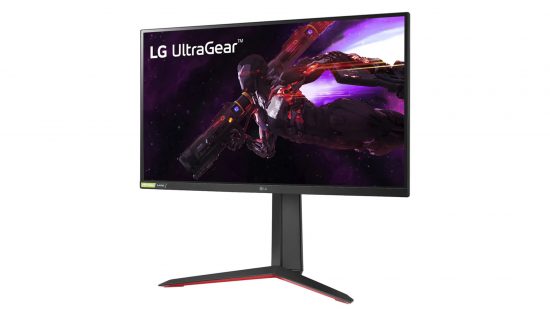
1. LG Ultragear 27GP850-B
The best 27-inch gaming monitor is the LG Ultragear 27GP850-B.
LG UltraGear 27GP850 specs:
| Screen size | 27-inch |
| Resolution | 2,560 x 1,440 |
| Panel technology | IPS |
| Maximum refresh rate | 165Hz (overclockable to 180Hz) |
| Stated response time | 1ms |
| Max brightness | 400cd/m² SDR |
| Backlight zones | 1 |
| Stated contrast ratio | 1,000:1 (SDR and HDR) |
| Adaptive sync | FreeSync Premium, G-Sync compatible |
| Display inputs | 1 x DisplayPort 1.2a, 2 x HDMI 2 |
| Audio | Headphone out |
| Stand adjustment | Height, pivot, tilt |
| Extras | 100 x 100mm VESA mount, 2 x USB 3 ports, DisplayHDR 400 certified |
Pros
- Class-leading gaming performance
- Excellent default image quality
- Exceptionally low response time
- Usable sRGB mode
Cons
- Stand lacks left/right rotation
- No speakers
- Basic design
LG’s gaming monitors have been among the top choices for several years now thanks to one key feature: fast response time. LG’s own IPS panels just have a faster native response time than most competing technologies, and while LG does sell its panels to some other monitor makers, its own monitors are among the best choices.
That’s why the LG Ultragear 27GP850-B is our pick for the best overall gaming monitor as its combination of a fast IPS panel that produces excellent image quality with a 27-inch screen size and 2,560 x 1,440 pixel resolution, makes for an ideal balance of features. It’s not too big or high resolution for fast-paced gaming nor too small or low resolution for desktop work or general entertainment – it’s the Goldilocks screen. Read our full LG UltraGear 27GP850 review.
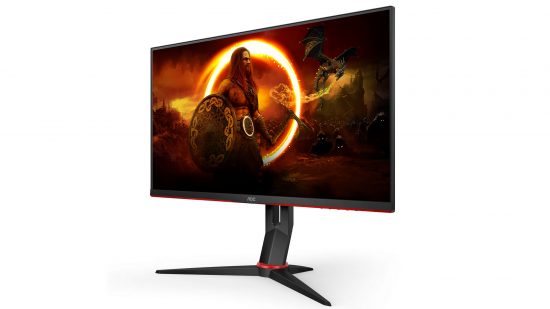
2. AOC 27G2SPU
The best budget 27-inch gaming monitor is the AOC 27G2SPU.
AOC 27G2SPU specs:
| Screen size | 27-inch |
| Resolution | 1,920 x 1,080 |
| Panel technology | IPS |
| Maximum refresh rate | 165Hz |
| Stated response time | 4ms GTG |
| Max brightness | 250cd/m² SDR and HDR |
| Backlight zones | 1 |
| Stated contrast ratio | 1,000:1 |
| Adaptive sync | FreeSync Premium, G-Sync compatible |
| Display inputs | 1 x DisplayPort 1.4, 2 x HDMI 2, VGA |
| Audio | 2 x 2W speakers, Headphone out |
| Stand adjustment | Height, pivot, rotation, tilt |
| Extras | 100 x 100mm VESA mount, four-port USB 3 hub, MBR blur reduction mode |
Pros
- Class-leading gaming performance
- Excellent default image quality
- Exceptionally low response time
- Usable sRGB mode
Cons
- Stand lacks left/right rotation
- No speakers
- Basic design
The AOC 27G2SPU delivers reliable gaming performance for a great price and on a screen that’s still just about large enough to sit back and watch when it comes to movie night. Its image quality is excellent right out of the box, it has good connection options and a versatile all for a compelling price. Its response time isn’t the fastest and its 1080p resolution is limiting for desktop work but it’s still a solid budget option for a 27-inch screen. Find out more in our full AOC 27G2SPU review.
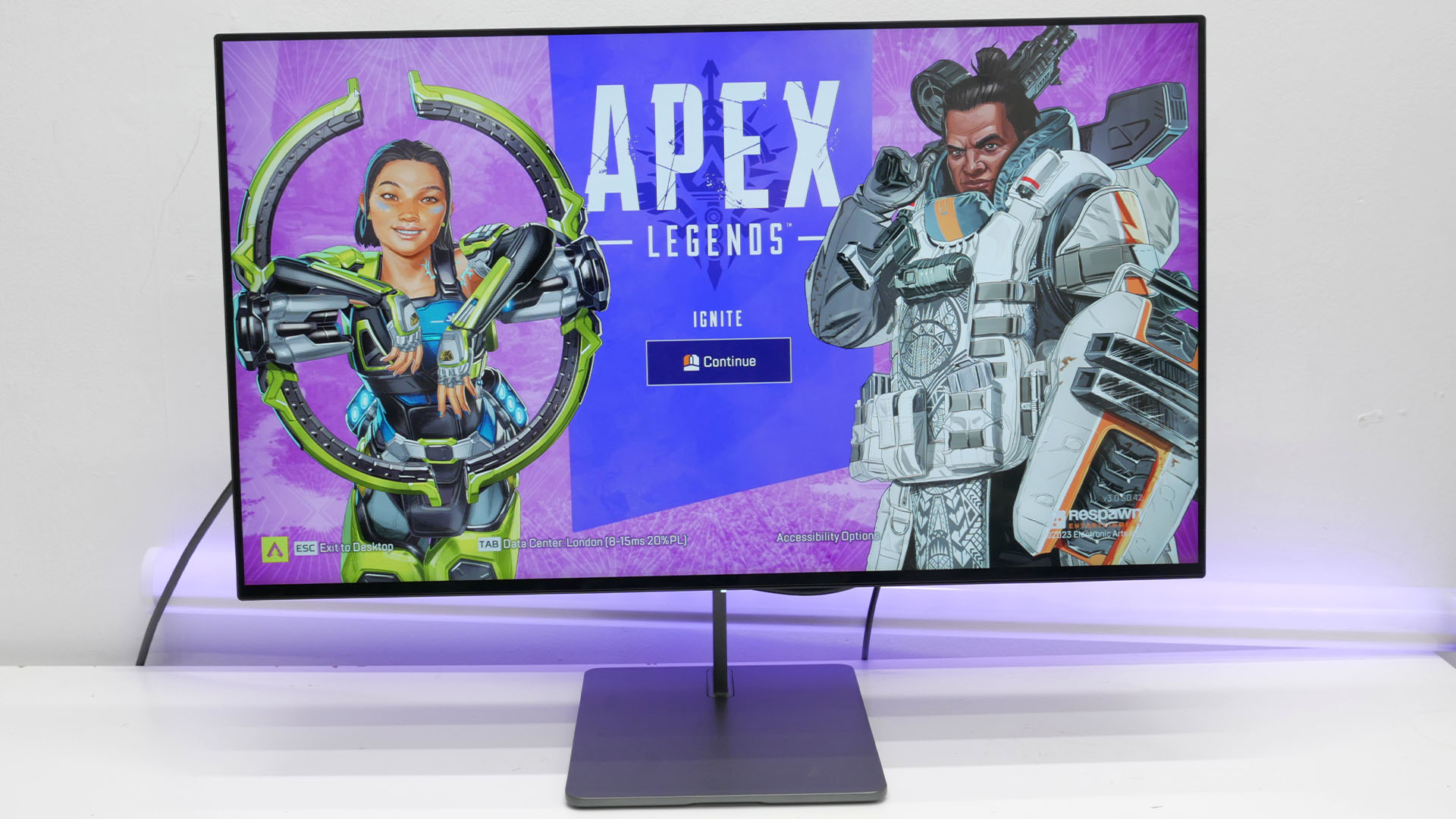
3. Dough Spectrum One
The best 27-inch 4k gaming monitor is the Dough Spectrum One.
Dough Spectrum One specs:
| Screen size | 27-inch |
| Resolution | 3,840 x 2,160 |
| Panel technology | IPS |
| Maximum refresh rate | 144Hz |
| Stated response time | 1ms |
| Max brightness | 600cd/m² |
| Backlight zones | 1 |
| Stated contrast ratio | 1,000:1 |
| Adaptive sync | FreeSync Premium, G-Sync compatible |
| Display inputs | 1 x DisplayPort 1.4, 2 x HDMI 2 |
| Audio | Headphoneout |
| Stand adjustment | Height, pivot, tilt |
| Extras | 100 x 100mm VESA mount, USB B 3.2 Gen 1 upstream port, 2 x USB A 3.2 Gen 1 downstream ports, 2 x USB C Gen 1 downstream ports with video input and 100W charging, optional stand |
Pros
- Stunning design when bought with stand
- Choice of glossy or matte screens
- Generally excellent image quality
- Surprisingly good gaming performance
- Low response time
Cons
- Expensive for the core spec
- Stand is an extra $99
- Glossy version $100 extra
- Even more expensive in Europe
The Dough Spectrum One earns its spot on our best gaming monitor list not because it’s exceptional value but rather because it combines excellent image quality and gaming performance with a design that’s a cut above the rest, at least if you buy it with the optional stand. It’s effortlessly sleek and beautifully made while offering height, pivot, and tilt adjustment. You can also buy the display without a stand for $99 less and it still makes for a very slim-framed, elegant option. All that and its picture quality is on par with any other 4K IPS screen and its gaming performance is surprisingly excellent with an average 4.5ms response time in our testing. Find out more in our full Dough Spectrum One review.
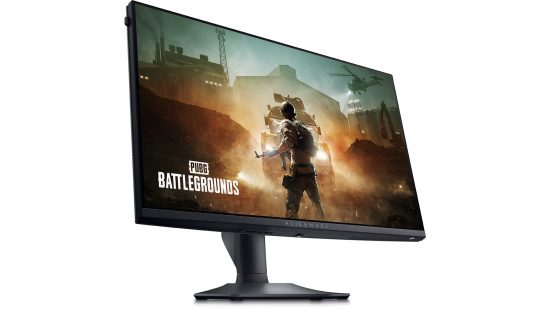
3. Alienware AW2523HF
The best esports gaming monitor is the Alienware AW2523HF.
Alienware AW2523HF specs:
| Screen size | 24.5-inch |
| Resolution | 1,920 x 1,080 |
| Panel technology | IPS |
| Maximum refresh rate | 360Hz |
| Stated response time | 1ms |
| Max brightness | 400cd/m² SDR |
| Backlight zones | 1 |
| Stated contrast ratio | 1,000:1 |
| Adaptive sync | FreeSync Premium, G-Sync compatible |
| Display inputs | 1 x DisplayPort 1.4, 2 x HDMI 2 |
| Audio | Headphone and line out |
| Stand adjustment | Height, pivot, rotation, tilt |
| Extras | 100 x 100mm VESA mount, DisplayPort cable, DisplayPort-to-mini-DisplayPort cable, USB 3 upstream cable, four-port USB 3 hub |
Pros
- Fantastic gaming performance
- Decent overall image quality
- Useful feature set
- Decent value
Cons
- No HDR
- Response time not that fast
- Low resolution
The Alienware AW2523HF boasts a 360Hz refresh rate, making it blisteringly fast and ideal for fast-paced eSports gaming. Its use of an IPS panel, rather than TN, means it doesn’t have quite as fast a response time as some screens but unless you’re truly gunning for professional eSports-level performance, that 360Hz refresh rate is enough.
Meanwhile, it’s a nicely designed screen that delivers great image quality right out of the box and its price is competitive. It’s only 1080p, which limits its appeal for work and other entertainment but is ideal for most eSports-type games (though a bit low for more detail-oriented titles such as Tarkov and CoD Warzone – 1440p monitors are better for seeing enough detail in those games). Read our full Alienware AW2523HF review for more details.
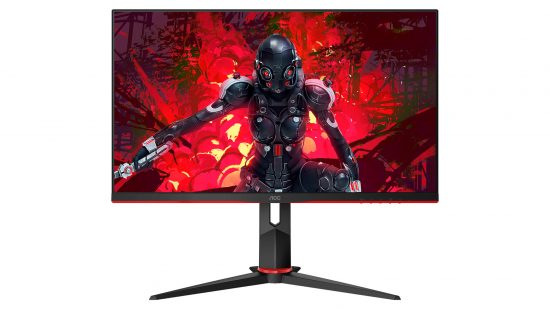
4. AOC 24G2U
The best budget 24-inch gaming monitor is the AOC 24G2U.
AOC 24G2U specs:
| Screen size | 23.8-inch |
| Resolution | 1,920 x 1,080 |
| Panel technology | IPS |
| Maximum refresh rate | 144Hz |
| Stated response time | 1ms |
| Max brightness | 400cd/m² SDR |
| Backlight zones | 1 |
| Stated contrast ratio | 1,000:1 |
| Adaptive sync | FreeSync Premium, G-Sync compatible |
| Display inputs | 1 x DisplayPort 1.2, 2 x HDMI 1.4, 1 x VGA |
| Audio | 2 x 2W speakers, headphone out, line in |
| Stand adjustment | Height, pivot, rotation, tilt |
| Extras | 100 x 100mm VESA mount, four-port USB 3 hub |
Pros
- Excellent image quality
- Loads of features
- Fantastic gaming performance
Cons
- Slightly underwhelming design
- Clunky OSD controls
- sRGB mode has fixed brightness
If you simply need a relatively small, relatively low-resolution monitor that delivers a 144Hz+ refresh rate for smooth gaming and doesn’t produce terrible image quality, the AOC 24G2SU is the panel for you. In fact, that sentence does it a disservice as this IPS gaming monitor produces great image quality. It’s also packed with features, including speakers and loads of connection options. For such a low price, it’s an ideal entry-level gaming monitor. Read our full AOC 24G2U review for more information.
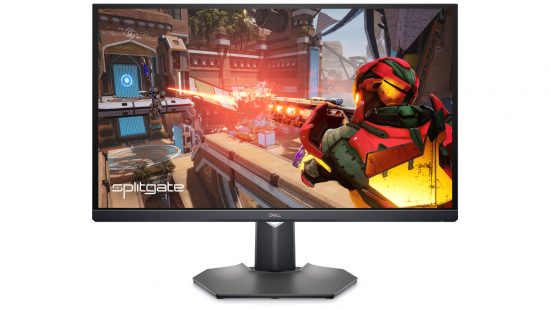
5. Dell G3223D
The best 32-inch gaming monitor is the Dell G3223D.
Dell G3223D specs:
| Screen size | 32-inch |
| Resolution | 2,560 x 1,440 |
| Panel technology | IPS |
| Maximum refresh rate | 165Hz |
| Stated response time | 1ms |
| Max brightness | 400cd/m² SDR |
| Backlight zones | 1 |
| HDR certification | DisplayHDR 400 |
| Stated contrast ratio | 1,000:1 |
| Adaptive sync | FreeSync Premium Pro, G-Sync compatible |
| Display inputs | 1 x DisplayPort 1.4, 2 x HDMI 2, USB Type-C DisplayPort 1.4 Alt mode |
| Audio | Headphone out |
| Stand adjustment | Height, rotation, tilt |
| Extras | 100 x 100mm VESA mount, USB Type-C upstream port with one USB 3 charging port and one USB 3.2 gen 1 downstream port, rear RGB lighting, DisplayPort and USB Type-C cables |
Pros
- Excellent image quality
- Useful USB Type-C video input
- Solid gaming performance
Cons
- Slightly low contrast ratio
- No backlight strobing blur reduction
A stylish design, useful feature set, great image quality, and solid gaming performance make the Dell an excellent, low-cost 32-inch gaming screen. It’s not the absolute fastest, and its contrast is a little low, but these considerations are balanced by its affordability. Find out more in our full Dell G3223D review.
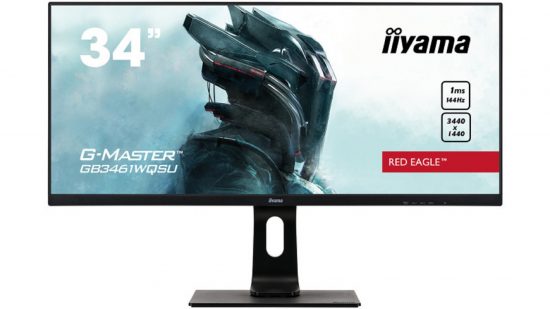
6. iiyama G-Master GB3461WQSU
The best 34-inch ultrawide gaming monitor is the iiyama G-Master GB3461WQSU.
iiyama G-Master GB3461WQSU specs:
| Screen size | 34-inch |
| Resolution | 3,440 x 1,440 |
| Panel technology | IPS |
| Maximum refresh rate | 144Hz |
| Stated response time | 1ms |
| Max brightness | 400cd/m² SDR |
| Backlight zones | 1 |
| Stated contrast ratio | 1,000:1 |
| Adaptive sync | FreeSync, unofficial G-Sync support |
| Display inputs | 2 x DisplayPort 1.2, 2 x HDMI 1.4 |
| Audio | 2 x 5W speakers, line-in, headphone out |
| Stand adjustment | Height, rotation, pivot, tilt |
| Extras | 100 x 100mm VESA mount, two-port USB 3 hub |
Pros
- Fantastic value
- Great image quality
- Good gaming performance
Cons
- Poor default color balance
- Lacks color gamut for HDR
- Staid design
The G-Master GB3461WQSU isn’t perfect, with less-than-ideal color balance out of the box, and a rather staid frame and stand design. However, it otherwise delivers great image quality and fantastic gaming performance, all for an astonishingly low price. If you’re short on cash but want a big gaming monitor upgrade, this is the one to buy. Find out more in the full iiyama G-Master GB3461WQSU review.
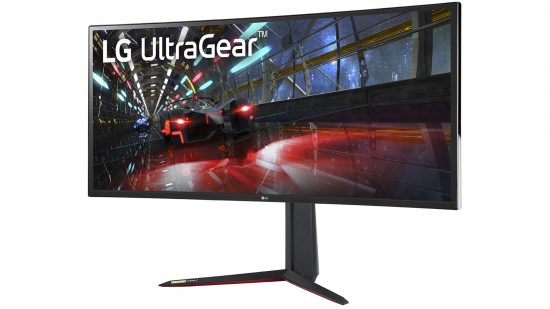
7. LG UltraGear 38GN950
The best 38-inch gaming monitor is the LG UltraGear 38GN950.
LG UltraGear 38GN950 specs:
| Screen size | 38-inch |
| Resolution | 3,840 x 1,600 |
| Panel technology | IPS |
| Maximum refresh rate | 144Hz (160Hz overclocked) |
| Stated response time | 1ms |
| Max brightness | 400cd/m² SDR |
| Backlight zones | 1 |
| Stated contrast ratio | 1,000:1 |
| Adaptive sync | FreeSync and G-Sync |
| Display inputs | 1 x DisplayPort 1.2, 2 x HDMI 1.4 |
| Audio | No speakers, headphone out |
| Stand adjustment | Height, tilt |
| Extras | 100 x 100mm VESA mount, 2-port USB 3 hub |
Pros
- Fantastic overall image quality
- Excellent gaming performance
- Big screen size and resolution
- Passable HDR
Cons
- HDR still not great
- No stand rotation or speakers
- Very expensive
This huge 38-inch panel packs in an equally whopping 3,840 x 1,600-pixel resolution, which is just a few pixels short of a 4K panel. This makes this display fantastic as a single-monitor replacement for twin-monitor setups. It also makes for a huge image when watching videos or gaming.
When it comes to the latter, the large panel size has diminishing returns for any sort of competitive gaming where you’re focused on a small central portion of the screen – and the high resolution will put a big strain on your graphics card – but it’s amazing for more cinematic games where you just want to take in the view. Read our full LG UltraGear 38GN950 review.
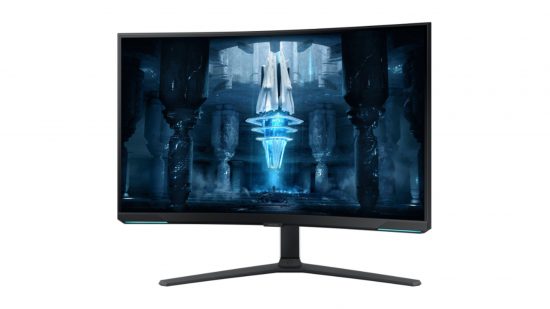
8. Samsung Odyssey Neo G8
The best 32-inch 4K gaming monitor is the Samsung Odyssey Neo G8.
Samsung Odyssey Neo G8 specs:
| Screen size | 32-inch |
| Resolution | 3,840 x 2,160 |
| Panel technology | VA |
| Maximum refresh rate | 240Hz |
| Stated response time | 1ms |
| Max brightness | 400cd/m² SDR, 2000cd/m² HDR |
| Backlight zones | 1 |
| Stated contrast ratio | 1,000,000:1 |
| Adaptive sync | AMD FreeSync Premium Pro, Nvidia G-Sync compatible |
| Display inputs | 1 x DisplayPort 1.2a, 2 x HDMI 2 |
| Audio | N/A |
| Stand adjustment | Height, tilt, swivel |
| Extras | 100 x 100mm VESA mount, 2 x USB-C 3.2 Gen 1 |
Pros
- Sensational contrast
- Fantastic backlight
- Good colors
- Excellent core specification
Cons
- Needs a mighty GPU
- Some exterior design issues
- Not the best for serious esports
With its 32″ panel size, 4K resolution, and 240Hz refresh rate, the Samsung Odyssey Neo G8 ticks a hell of a lot of boxes for a gaming monitor. What’s more, its VA LCD panel provides a staggeringly high native contrast ratio plus the use of over a thousand individual backlights allows for even higher contrast, making for stunning HDR.
Despite VA panels generally suffering from slow response times, this panel also has a lightning-quick response once you apply a bit of overdrive. It really is the one monitor that can do it all, which is why it costs quite so much. Read our full Samsung Odyssey Neo G8 review.
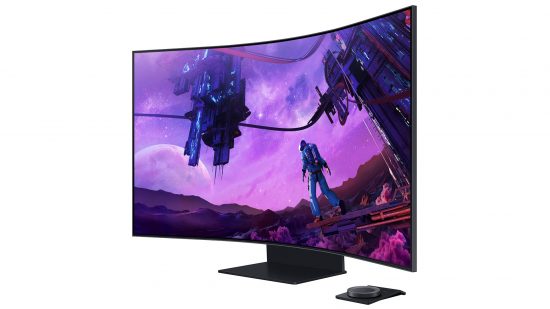
9. Samsung Odyssey Ark
The best 55-inch 4K gaming monitor is the Samsung Odyssey Ark.
Samsung Odyssey Ark specs:
| Screen size | 55-inch |
| Resolution | 3,840 x 2,160 |
| Panel technology | VA |
| Maximum refresh rate | 165Hz |
| Stated response time | 1ms |
| Max brightness | 400cd/m² SDR, 2000cd/m² HDR |
| Backlight zones | 1 |
| Stated contrast ratio | 1,000,000:1 |
| Adaptive sync | AMD FreeSync Premium Pro, Nvidia G-Sync compatible |
| Display inputs | 1 x DisplayPort 1.4, 2 x HDMI 2 |
| Audio | Headphone out, 4 x speakers, 2 x subwoofers |
| Stand adjustment | Height, pivot, tilt |
| Extras | 100 x 100mm VESA mount, 1 x USB Type-C 3.2 Gen 1, 2 x USB 2, One Connect box, 100Mbps Ethernet, Wi-Fi 5, Bluetooth 5.2 |
Pros
- Incredible, immersive design
- Great image quality
- Loads of adjustment
- Powerful speakers
Cons
- HDR could be even better
- Some underwhelming features
- Hugely expensive
The colossal 55-inch size of this screen makes it part TV, part gaming monitor, a status that’s confirmed by its presence of a hefty sound system, smart TV apps and even a remote control. However, this monitor still has plenty of more standard gaming monitor features going for it, with an adjustable stand and a speedy 165Hz refresh rate.
It has a 4k resolution and produces stunning contrast thanks both to the native contrast of the VA LCD panel and the use of a multi-zone backlight, resulting in mesmerizing HDR. It’s hugely expensive and very much overkill for most users but it’s also a sight to behold. Find out more in our Samsung Odyssey Ark review.
How we test gaming monitors
We thoroughly test every monitor we recommend, checking for its real-world image quality using an X-Rite i1Display Pro colorimeter as well as testing for more subjective factors like viewing angles. We also game-test every display with several hours of playtime along with objective tests of response time using an OSRTT tool. You can find our full monitor test procedure on our how we test page.
Gaming monitor frequently asked questions (FAQ)
What is a gaming monitor?
Gaming monitors have a fairly broad definition these days but fundamentally, what most sets them apart from non-gaming displays is they generally have a faster refresh rate, a display that’s optimised for speed over pure image quality, and have extra features targeted at gamers.
For the most part, it’s the refresh rate that’s the key feature. Monitors used to be stuck at 60Hz maximum refresh rates, which while adequate for desktop work, watching video, and playing slower-paced games (anything from The Sims to single-player FPSes) can make certain games look choppy feel sluggish. Any sort of game where things are moving quickly on screen or fast reactions are required will benefit from a screen with a faster refresh rate.
Meanwhile, gaming features can include things like on-screen crosshairs (for getting round games where accuracy is important but the game doesn’t provide a crosshair), programmable modes for quickly switching the screen setup between different games, and physical extras like popout headphones stands. Oh, and of course some have RGB lighting.
What refresh rate do I need?
Refresh rate is crucial for any game where fast movement is occurring on screen or where fast reactions are required. Plus, a faster refresh rate just looks smoother, making even slower-paced games feel nicer to play – there’s a reason why many modern phones even have 120Hz displays these days.
The baseline refresh rate for any monitor is 60Hz, and that’s fine for the slowest of games – think chess or The Sims – but even stepping up to 75Hz makes a surprising difference to the smoothness of a game.
However, for most faster-paced games – think competitive shooters, racing games, flight sims, etc – 120Hz is generally considered the minimum to aim for. Motion feels so much smoother and you can react so much quicker to what’s happening in the game.
For truly competitive gamers, moving up to a 240Hz screen can provide a fairly easily discernible benefit but much beyond that difference is small – and other factors like response time come ever more into play.
What is response time?
Response time is the time it takes for the pixels of a monitor to change from one color to another. It is measure in milliseconds and ranges from around 20ms on the slowest monitors to 0.1ms on the fastest OLED monitors. The lower/faster the response time, the quicker the display can show the new image that has just been sent to it.
Crucially, particularly for LCD monitors – as opposed to OLED monitors – response time can vary depending on which color a pixel is starting at and changing too. That’s why companies can claim 1ms response times on the box but, when tested, the average response time can be 4x, 5x, 6x the amount.
A slow response time can result in there being ghostly trails behind moving objects, as the pixels are still changing color while being asked to show yet another new image. At best this can make for a slightly smudgy, unclear image and worst this can make a display almost unusable.
The most crucial consideration is that a gaming monitor should ideally have an average response time that’s lower than the frame time of the refresh rate of the display. What does that mean? Well, the frame time is simply the time each frame is shown according to the refresh rate. So a 60Hz screen has a frame time of 1 second / 60 frames a second, or 16ms. Meanwhile a 120Hz screen has a frame time of 8ms and a 240Hz screen halves that again to 4ms. If your screen is 240Hz but has an average response time of 8ms, it’s going to look real bad.
We test all monitors we review with an open source response time tester that accurately measure the average response time of a panel, giving you a true picture of how snappy a monitor will look and feel.
Found the gaming monitor of your dreams? Why not check out our best gaming mouse and best gaming keyboard guides to complete your setup?
